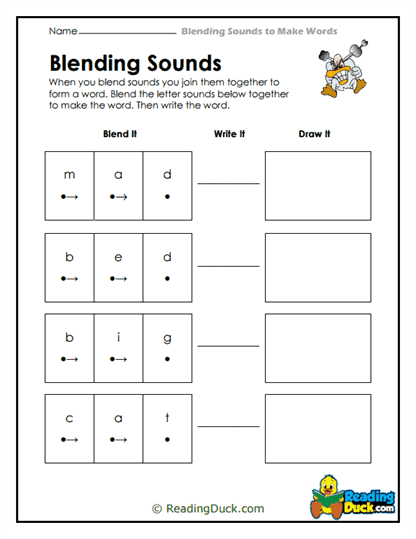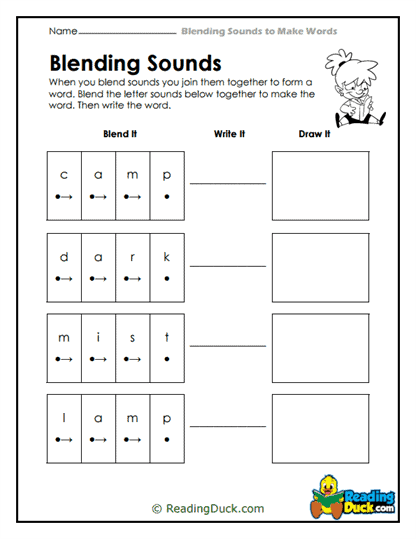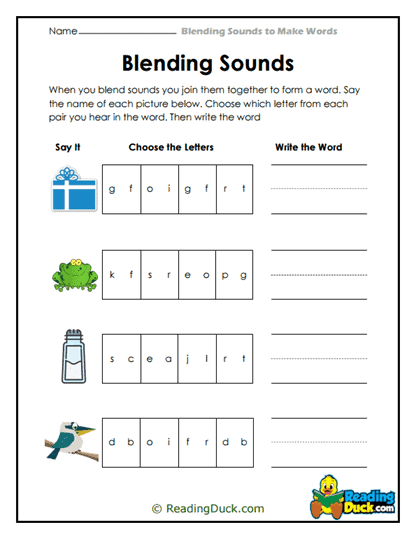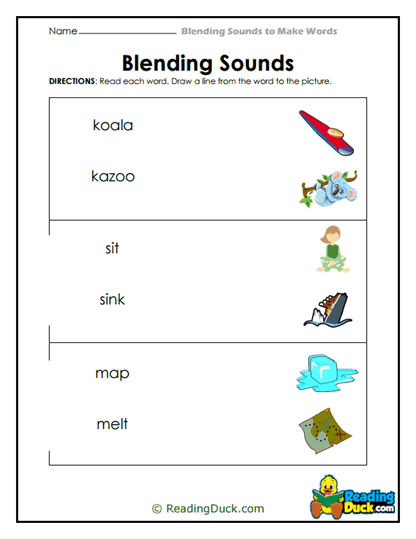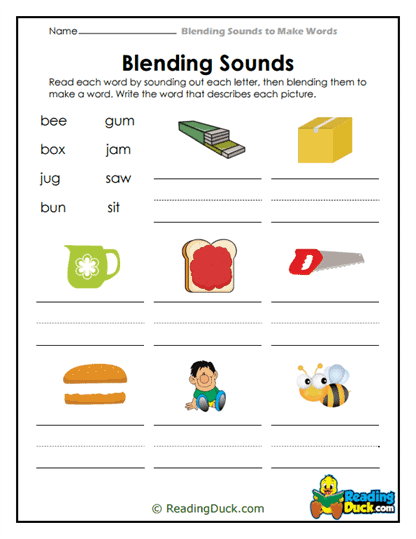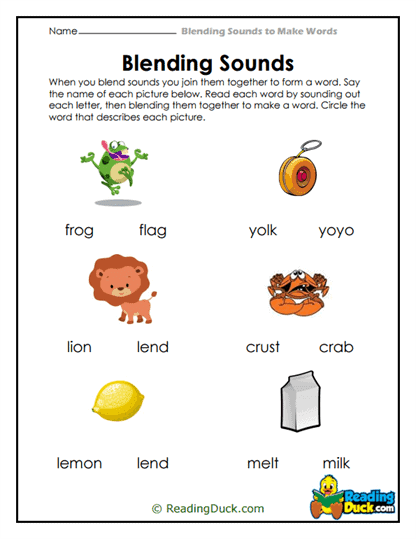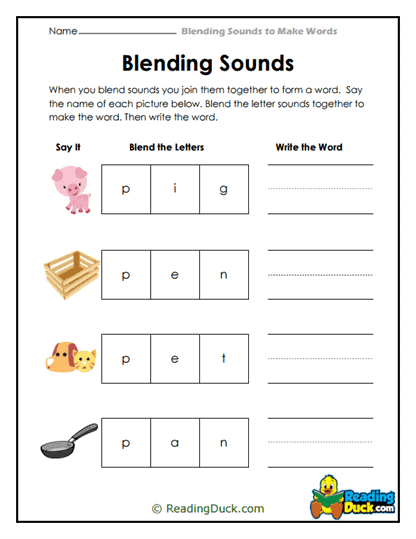Blending Sounds Worksheets
About Our Blending Sounds Worksheets
Our Blending Sounds Worksheets are expertly crafted resources aimed at helping young learners develop one of the most critical phonemic awareness skills: blending sounds to form words. These worksheets fall under the 'Phonics' category within the 'Pre-Reading' section and are ideal for children in pre-kindergarten through first grade. Available in a user-friendly PDF format, these worksheets can be easily viewed, downloaded, and printed, making them highly versatile for both classroom instruction and home learning. Each worksheet is accompanied by a downloadable answer key, enabling educators and parents to assess and monitor progress effectively.
Understanding the Concept of Blending Sounds
Blending sounds is a fundamental skill in phonemic awareness and early reading development. It involves smoothly combining individual phonemes (sounds) to form whole words. Let’s explore this concept in more detail to understand its importance in early literacy.
What Is Sound Blending?
Sound blending, or phoneme blending, is the process of taking individual sounds and merging them together to form a complete word. For example, when the sounds /c/, /a/, and /t/ are blended together, they form the word "cat." This skill is crucial for decoding words when reading, as it allows children to recognize and pronounce words by merging the individual sounds they hear or see in print.
The Importance of Blending Sounds in Early Literacy
- Essential for Decoding: Blending sounds is a key component of decoding, which is the ability to read new words by sounding them out. Children who can blend sounds efficiently are better equipped to tackle unfamiliar words during reading.
- Foundation for Reading Fluency: Once children master blending, they can read more fluently and with greater accuracy. This is because they can quickly merge sounds into words, reducing the need for slow, laborious sounding out.
- Supports Vocabulary Growth: As children become proficient in blending, they are able to read a wider variety of words, which naturally expands their vocabulary and language comprehension.
- Improves Spelling Skills: Blending sounds also reinforces spelling abilities, as it helps children understand how sounds correspond to letters and letter patterns in words.
Examples of Blending Sounds
Here are some examples to illustrate how blending sounds works:
- The sounds /s/, /u/, and /n/ blend together to form the word "sun."
- The sounds /m/, /a/, and /p/ blend together to create the word "map."
- The sounds /b/, /l/, /a/, and /k/ blend together to form the word "black."
By practicing sound blending, children learn to hear words as a whole and improve their ability to decode new words while reading.
How These Worksheets Facilitate the Development of Blending Skills
Our Blending Sounds Worksheets are thoughtfully designed to provide young learners with the practice they need to master the skill of blending sounds. These worksheets play a crucial role in helping children develop the ability to smoothly combine sounds into words, which is essential for successful reading.
Structured and Systematic Practice
The worksheets offer structured practice in blending sounds, which is essential for building confidence and proficiency. The exercises are designed to guide children through the process of hearing individual sounds and combining them to form words, helping them internalize this critical phonemic skill.
Engaging and Interactive Learning
These worksheets encourage active participation from children, engaging them in the learning process. By focusing on the task of blending sounds, children are challenged to think critically about how sounds come together to create meaningful words, making the learning experience both effective and enjoyable.
Adaptable to Different Learning Styles
Whether a child is more visual or auditory, these worksheets are adaptable to various learning styles. Visual learners benefit from seeing the letters that correspond to the sounds they are blending, while auditory learners can focus on hearing and repeating the sounds as they work through the worksheets.
Gradual Increase in Complexity
The worksheets may be designed to gradually increase in complexity, allowing children to start with simple sound blends and progress to more challenging ones as their skills improve. This gradual progression ensures that children build their blending skills at a comfortable and manageable pace.
Learning Objectives of the Blending Sounds Worksheets
The Blending Sounds Worksheets are created with clear educational goals in mind, all aimed at fostering essential early reading skills in young learners. The key learning objectives of these worksheets include:
- Develop Phonemic Awareness: The primary objective is to help children enhance their phonemic awareness by mastering the ability to blend individual sounds into whole words.
- Improve Decoding Skills: Through regular practice, children will improve their ability to decode unfamiliar words by blending the sounds they recognize, which is crucial for reading fluency.
- Build Reading Fluency: As children become proficient in blending sounds, they will read more fluently and with greater ease, allowing them to focus on comprehension rather than decoding.
- Expand Vocabulary: By practicing blending sounds, children will encounter and learn new words, helping them to expand their vocabulary and improve their language skills.
- Strengthen Spelling Abilities: Understanding how sounds blend together in words also supports spelling, as children learn to break down words into their component sounds and letters.
Practical Strategies for Educators and Parents Using Blending Sounds Worksheets
To ensure that these worksheets are used effectively, here are some practical strategies for educators and parents:
Incorporate Blending Practice into Daily Routines
Daily practice is essential for mastering the skill of blending sounds. Incorporate these worksheets into daily literacy routines, whether as part of a morning activity in the classroom or a regular homeschool schedule.
Pair with Oral Blending Activities
While the worksheets provide valuable written practice, it’s important to pair them with oral blending activities. For example, play games where you say individual sounds and ask the child to blend them into a word, or use a whiteboard to write down sounds and blend them together as a group.
Utilize Multi-Sensory Learning Techniques
Multi-sensory learning can be highly effective in reinforcing the concepts taught in the worksheets. Consider using tactile letters or blocks to represent sounds, allowing children to physically manipulate and blend the sounds together.
Encourage Peer Learning
In a classroom setting, consider pairing children together to work on the worksheets. Peer learning allows children to learn from each other, share strategies, and reinforce their understanding of sound blending.
Monitor Progress and Adjust Accordingly
Use the answer keys provided with each worksheet to monitor a child’s progress. This will help you identify areas where they may need additional support or practice, allowing you to adjust your teaching strategies as needed.
Make Learning Fun and Interactive
Incorporate games and interactive activities that focus on blending sounds to make learning more enjoyable. For example, you can create a "blending bingo" game where children match blended sounds with corresponding words on their bingo cards.
The Role of Blending Sounds Worksheets in a Comprehensive Phonics Program
Incorporating Blending Sounds Worksheets into a comprehensive phonics program offers significant benefits for young learners as they develop their early reading skills. Here’s how these worksheets contribute to a well-rounded literacy education:
Laying the Groundwork for Reading Success
Blending sounds is a foundational skill in phonics and early reading. By mastering the ability to blend sounds, children are better prepared to tackle more advanced phonics concepts, such as segmenting sounds, recognizing word patterns, and understanding syllables.
Enhancing Reading Fluency and Confidence
As children become proficient in blending sounds, they experience greater reading fluency. This fluency allows them to read more smoothly and confidently, which in turn enhances their overall reading experience and encourages a love of reading.
Supporting Diverse Learning Needs
The worksheets are designed to be flexible and adaptable to various learning environments and student needs. Whether used in a traditional classroom, for homeschooling, or in one-on-one tutoring, they provide a versatile tool that can be tailored to support different learning styles and paces.
Promoting Lifelong Literacy Skills
Mastery of blending sounds is not only crucial for early reading success but also serves as a building block for lifelong literacy skills. Children who can blend sounds effectively are more likely to develop strong decoding skills, which are essential for reading comprehension and language development throughout their lives.
Building a Strong Foundation for Advanced Phonics Instruction
Once children have mastered sound blending, they are ready to move on to more advanced phonics instruction. The skills they develop with these worksheets will serve as a foundation for future reading and writing tasks, ensuring they are well-prepared for the challenges of more complex literacy learning.
In conclusion, our Blending Sounds Worksheets are an indispensable resource for fostering early literacy skills. By focusing on the critical skill of sound blending, these worksheets provide young learners with the tools they need to become confident and capable readers. Whether used in a classroom, at home, or in a tutoring environment, these worksheets are designed to support the development of essential phonemic awareness skills that are foundational for reading success.
